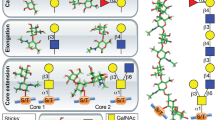Abstract.
The xylosyltransferases I and II (XT-I, XT-II, EC 2.4.2.26) catalyze the transfer of xylose from UDP-xylose to selected serine residues in the proteoglycan core protein, which is the initial and ratelimiting step in glycosaminoglycan biosynthesis. Both xylosyltransferases are Golgi-resident enzymes and transfer xylose to similar core proteins acceptors. XT-I and XT-II are differentially expressed in cell types and tissues, although the reason for the existence of two xylosyltransferase isoforms in all higher organisms remains elusive. Serum xylosyltransferase activity was found to be a biochemical marker for the assessment of disease activity in systemic sclerosis and for the diagnosis of fibrotic remodeling processes. Furthermore, sequence variations in the XT-I and XT-II coding genes were identified as risk factors for diabetic nephropathy, osteoarthritis or pseudoxanthoma elasticum. These findings point to the important role of the xylosyltransferases as disease modifiers in pathologies which are characterized by an altered proteoglycan metabolism. The present review discusses recent advances in mammalian xylosyltransferases and the impact of xylosyltransferases in proteoglycan-associated diseases.
Similar content being viewed by others
Author information
Authors and Affiliations
Corresponding author
Additional information
Received 9 February 2007; accepted 5 March 2007
Rights and permissions
About this article
Cite this article
Götting, C., Kuhn, J. & Kleesiek, K. Human xylosyltransferases in health and disease. Cell. Mol. Life Sci. 64, 1498 (2007). https://doi.org/10.1007/s00018-007-7069-z
Published:
DOI: https://doi.org/10.1007/s00018-007-7069-z




